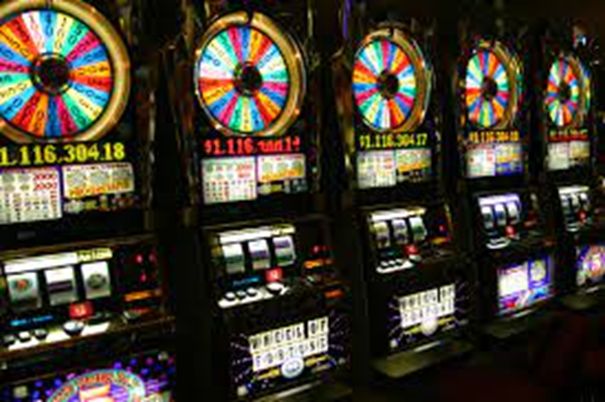Slot machines go by various names. English call them fruit machines or frutties. Sin Scotland, they are known as puggies, while Aussies call them poker machines or pokies. Regardless of the name, they are equally popular everywhere and are considered the most popular gambling game in the world. In traditional casinos, slot machines take up around 70% of available floor space and are responsible for an equal share of the revenue a casino makes. Despite games like poker, blackjack, and roulette being more glamourous, slots are the bread and butter of any gambling establishment. They are easy to learn and don’t require comp0licated strategies and an advanced math degree to play and enjoy, unlike some other games. Perhaps that is the reason why you never see James Bond playing them.
How Slots Machines Work
The basic principle of gameplay remained the same throughout the evolution of slot machines technology. Every slot features a row or rows of symbols. Some have three reels per row, others five or even more. The idea is to create a winning combination of symbols to achieve victory and payment. Over time, symbols changed, but the most popular are various fruit, bars, diamonds, and others. In the old days, a player started the spinning reels by pulling on a lever on the side of the machine. With the introduction of electromechanical slots, the lever lost its function and was eliminated. Modern slots use buttons to activate reels and start playing. Many older players agree that something was lost in transition and that pulling a lever was an experience slots today just can’t provide.
Mechanical Age
It all started in New York. In 1891, Sittman and Pitt of Brooklyn created a machine with five reels with card symbols. Winning combinations were based on poker. This was the grandfather of all slot machines today. A few years later, Charles Fey of San Francisco made a much simpler contraption, with only three reels and just five symbols: hearts, spades, diamonds, horseshoes, and Liberty Bell, which gave the machine its name. Liberty Bell machines proved extremely popular, partly due to the fact that they could handle automatic payouts, due to a much lower number of winning combinations. They spread like a wildfire across the country and soon, almost every saloon, bar, tobacco shop, and even brothels had at least one of them in the corner. The jackpot was ten nickels and you need to get three Liberty Bells in a row to win it. The design was so successful that people started to copy it to satisfy the demand.
Electronic Age
Electronic slots came fairly late compared to other electronic gambling devices. The first electronic slot was created in the 1960s and although its internal mechanism was powered by electricity, it still kept the lever on the side, although it functioned simply as a switch. The designers thought that a slot machine without a recognizable lever wouldn’t attract players, even though it was completely redundant. New slots proved equally popular as their purely mechanical ancestors and soon replaced them almost everywhere. Old one-armed bandits were only kept for nostalgic reasons and even several casinos on the Strip still have some. The first electronic slot was called Money Honey and it featured a bottomless hopper, a huge coin depository, which allowed them to make payments of up to 500 coins, something older slots couldn’t come close to.
Video Age
The late 1970s and 1980s was the time when video games exploded. In 1978, Atari released Space Invaders, the game that established several important principles video games adhere to this day. The slot designers were quick to see the potential of new technology and went about implementing it. Thus, the first video slots were born, featuring a rudimentary random number generator. It was a far cry from modern RNGs, but it served its purpose and made playing video slots possible. It was made in Kearny Mesa California by a company called Fortune Coin. The slot featured a modified 19-inch Sony Trinitron display. It had its debut at the Las Vegas Hilton Hotel and soon, every casino on the Strip had rows of them. From Vegas, they spread around the country and later the world.
Online Age
The 1990s saw one of the greatest inventions in the history of humankind – the Internet. Not long after, the first online casinos appeared and soon after, the first online slot games. Following the established pattern, they quickly became the most popular games in online casinos, just like in brick-and-mortar ones. Today, only sports betting is a more popular gambling activity than online slots. Games like poker and blackjack don’t even come close. Modern online slots look more like video games than classic slot games. They feature bonus levels, mini-games, and various winning combinations. Defined by the number of paylines they offer, most online slots let you choose how much you want to bet on every spin. Bets can be as low as five cents or as high as $100.
Progressive Slots
Progressive slots are no so much a type of slots, but rather the way they are connected and function as one giant jackpot machine. The first progressive slot was launched in March of 1986, by a company called International Game Technology (IGT). It was a series of slots locally connected and all working toward the same jackpot. As time passed, the chances of getting it grew progressively (hence the name). As technology and networking capabilities grew, we got bigger and bigger networks. Today, several states run state-wide progressive slots. They are responsible for some of the biggest jackpots in history like the one paid out in the United Kingdom. An Afghan veteran decided to pass the time in the evening after work by playing Mega Moolah and won 21 million euros. To this day, it is one of the largest jackpots ever won.

